
The Interviewees

Interview with Houssine Alloul (Univ. of Amsterdam) on his current book project, The Business of Diplomacy: Belgium and the Ottoman Empire in The Age of Capital - September 2021
1- Belgium is one of the most recent states of Western Europe founded in 1830 and despite its relatively small size embraced the Industrial Revolution early on, helped by such factors as the availability of cheap coal and the expatriate Englishman industrialist and organiser John Cockerill, leading to great prosperity. Was this combination of industrial competence and availability of capital the chief drivers of its overseas investments?
Yes, the gradual and then massive outlay of Belgian capital overseas was related to some of the factors you mention. Foreign capital and know-how, and certainly geography, were important for the initial development of an industrial economy. Essential fossil fuels (coal) and minerals (iron ore) were plentiful and labour was cheap. We also need to add another factor: state aid to capital through fiscal deregulation and the stimulation of free trade regimes. Equally crucial were changes in the world of finance. The emergence in the early 19th century of ‘new’ institutions like the société anonyme (joint-stock company) and the so-called banque mixte (the holding company avant la lettre) allowed for the concentration and accumulation of unprecedented amounts of capital. These bodies would later become involved in the dramatic spike in Belgian foreign direct investments (FDI), especially in Latin America and, most spectacularly, Russia.
2- The Ottoman state went bankrupt in 1875 and Belgian was one of the 4 major holders of the foreign debt. Was this debt administration a further means of European powers exercising economic dominance in the Ottoman financial and services sector as they were able to dictate terms in line of repayment of loans?
There is a lot of sophisticated work out there that has shown that the foreign-controlled Ottoman Public Debt Administration was instrumental in rendering the Ottoman Empire into a ‘debtor nation.’ At the same time, Istanbul clearly retained a degree of economic autonomy that distinguished it from other indebted states. From the 1890s on, the empire even negotiated new loans that, at least in the short run, were quite favourable.
3- The Liège arms factories (e.g. Fabrique Nationale) provided a substantial amount of weaponry to the Ottoman Empire. Presumably as today the arms trade was lucrative but did it also bring its interlockers close to the Ottoman centre of power in terms of influence as they were supplying something vital to an Empire with threatened borders?
Throughout the long nineteenth century, the Kingdom of Belgium, and in particular the area of Liège, was among the world’s biggest producers of arms and exported them over the entire globe. The Ottoman military was a long-time customer and, since at least the 1820s, Liège manufacturers secured several large orders from Istanbul. The politics of these orders and the (in)formal networks that facilitated them are difficult to reconstruct. Jan Anckaer found that, in the second and third quarters of the century Istanbul dispatched several officers to Liège to place and follow up on weapons orders, establishing direct, unmediated ties between local manufacturers and the imperial state. What is interesting also is that some of these men later rose to eminent positions in the Ottoman bureaucracy. Sakızlı Ahmed Esad Pasha, grand vizier for two brief terms in the mid-1870s, resided in Liège between 1864-1866. But while more research is certainly necessary, it appears the Belgian arms industry gradually lost its competitive position and, by the late 1880s, no longer was a match for Germany. Like the railway business, the arms trade became increasingly enmeshed with the intra-imperialist competition for spheres of influence and the Liège firms lacked the kind of extensive support the Wilhelmine government ensured its capitalists abroad. That does not mean, of course, that the industry did not continue to profit indirectly through subcontracting.
4- Was Belgium at an advantage regarding other European powers out to make money in the Ottoman world because of its middle power status with no history of convoluted history of rivalries and did Belgium use this 'neutrality' to reach out to new players perhaps lower in the pecking order of decision making in the Porte, but a valid long-term strategy of gaining concessions as these bureaucrats would often later rise to prominent positions. Do you think Belgium was better than the bigger powers when it came to the long-game of informal networking?
Belgium was no match for France and Germany, which came to dominate the most profitable sector for foreign capital expenditure in the empire – railways –, precisely for the reasons I mentioned earlier and despite its great productive industrial capacity. But we should remember that scale and size of FDI do not tell the whole story. Russia and Austria-Hungary’s position in this regard was insignificant, yet it did not prevent them from wielding considerable influence in the empire. But to go back to railway construction: Belgian capitalists did profit indirectly. French concerns constructing rail tracks in the Arab provinces subcontracted several Belgian steel and machine manufacturers. And the Ottoman government’s prestigious Hejaz railway project also proved lucrative for Belgian steel producers, including Cockerill, which delivered locomotives, sleepers and steel tracks.
Belgian financiers did gain a dominant position in the less capital-intensive urban public utilities sector. In cities such as Salonika, Istanbul, Izmir, Beirut and Damascus Belgian companies installed municipal trams and provided water, gas, and, later, electricity. But that the ‘Belgianness’ of these investments was not always directly recognized makes the story more complex. It is through the painstaking work of the late Jacques Thobie, the economic historian of French Empire, that we know something about the financial composition of the companies involved. He distinguished 16 companies in which Belgian capital-participation was either dominant or considerable; nearly all their company directors were Belgians. So, in fin-de-siècle Istanbul alone, Belgian financiers practically monopolized the city’s lighting systems through companies like the Gaz de Scutari (est. 1891) and Gaz de Stamboul (est. 1892). In Salonika too, Belgian capital proved momentous in changing the cityscape. There, Belgian interests had obtained a monopoly position in municipal utilities (water supply, street lightning, and urban transportation) and the provisioning of gas and later electricity to private persons (Image 1). How some of these initiatives came about and what kinds of social networks they spawned are central questions I explore in my book project.
This brings me to the last part of your question. I do not think Belgium’s official/nominal status as a neutral played a great role in this story. Neutrality was certainly a popular trope with diplomats and investors, but ultimately it was Belgium’s technological lead and low production costs that accounted for the country’s competitive position. Neither do I think Belgian diplomatic and financial players had a possible edge regarding informal networking. In the end, what ultimately distinguished the Belgian-Ottoman relationship from other Western economic powers’ engagement with Istanbul is the absence of semi-imperial attitudes and power relations.
5- Faustin Glavany was the third envoy to represent the Ottoman Empire in Belgium, was a prominent Levantine, businessman and scholar and many family members married into Belgian emigre families in Istanbul. So, can we argue that the Ottomans were also playing the same game of mixing diplomacy, business facilitation and influence in the West?
His family was well established in Istanbul and, as far as I can tell, entertained relations with traders from the Southern Netherlands as early as the 1820s. But the example of Faustin Glavany is a bit unusual, as there were few Levantines in Ottoman diplomatic service. It is more difficult to speak about Ottoman field diplomats as a collective. We know many resembled their Western European peers with regards socio-cultural preferences (language, morals, behavioural rules). But the interlocking of the private and professional in this ‘cosmopolitan’ milieu is not a straightforward story and requires more research. In the case of the Belgian diplomats, for example, we find many instances of agents employing their position to further their own, relatives, or friends’ private interests. But we also see several instances of diplomats remaining aloof from, if not outright disdainful of the ‘new’ world of finance and industry. They only reluctantly engaged in economic diplomacy. At the same time, the increasing pull of capital affected the diplomatic class everywhere. In my forthcoming book I show this is something rarely appreciated in the literature and contradicts the well-worn (self)image of diplomats as some kind of timeless courtiers well-versed in high politics (and culture) and indifferent to anything as prosaic as commerce.
6- You have been able to highlight in detail the personal interactions between the Ottoman and Belgian diplomatic elite and go-betweeners with a variety of letters and photo ephemera, something that would be almost impossible to reconstruct in that detail if based on official governmental records. What were your chief sources of information?
If we want to reconstruct the details of that ‘messier’ side of a diplomatic world that outwardly appears highly formalized and inaccessible, private archives are indispensable. The same applies when the aim is to identify and give voice to important actors usually not associated with the worlds of finance and high diplomacy: petty officials, intrepid engineers or enterprising (converted) military men. I consulted the private papers of several diplomats. Two collections proved particularly illuminating: the papers of Jules Greindl (b. 1835) (see Image 2) and Émile de Borchgrave (b. 1837). Both carved out ‘stellar’ careers for themselves. Their voluminous private archives were donated to the Belgian state, are fully accessible, and shed light on their entire careers. Mining through these extensive papers revealed immense social networks spanning the worlds of finance, politics, and learned societies. They also contained letters to and from Ottoman diplomats that attest to deep and longstanding friendships that challenge any notion of a supposed Ottoman provincialism.
7- ‘Methodological nationalism’ is clearly a danger when dealing with the trade and investment in the Ottoman world as looking at it in modern eyes in terms of semi-colonialism clearly can lead to false conclusions and in many cases the starting capital for these Belgian investments came from Paris or London. To what extent do you think there was a strategic and public relations need to show these companies as ‘local’ or deliberately make it vague?
Absolutely. So, while in certain cases one can clearly retrace investments to major Belgian investment banks and can legitimately speak of a Belgian-controlled firm (see my earlier comments), the picture becomes more convoluted higher up the hierarchy. Belgium’s liberal economic regime was exceptionally attractive to foreign capitalists, who (co)founded numerous enterprises in Brussels that were often Belgian in name only, in the sense of having their registry in Brussels. Significant overlaps existed in particular between Belgian, French and German capital. Indeed, Belgium offered opportunities for capitalist collaboration, which in times of nationalist fervour could not bear the light of day. So, insisting on national labels to describe firms operating under a specific flag in this period can be misleading.
That said, I do think we should continue to pay attention to very specific ‘national’ contexts. The formation of different capitals often has very particular local and national ‘origin stories.’ Perhaps there is no better illustration of this than the example of the legendary Orient Express (Image 3). It was conceived by Georges Nagelmackers (see Image 4), a financial tycoon and scion of an old Liège family of bankers that had an important stake in the early development of industrial manufacture in Wallonia. There is a direct if rarely recognized link, then, between these Belgian financiers and the later multinational giant (Co. Int. des Wagon-Lits) that would launch its famous luxury train in the Ottoman Balkans. In some ways this story about the now obscure Nagelmackers is telling for the way Belgium and the Ottoman Empire are rarely thought together.
As to the final part of your question: the foreign-financed urban public utilities firms (gas, trams, water) that figure in my research were in strictly legal terms nearly all Ottoman firms, registered in the empire, and with names carrying an “Ottoman” appellation; e.g. İzmir Suları Osmanlı Anonim Şirketi/Compagnie Ottomane des Eaux de Smyrne (est. 1895, see Image 5). But this was merely a trick to fool the public as to where their real financial power lay, as their administrative office was in Belgium. It does signal a certain anxiety on the part of both foreign investors and their local backers about such constructions.
8- Through your extensive investigations you were able to find many marriage and trading connections across the Levantine / diplomatic world of the Ottoman Belgian community in Istanbul as shown by your section of the Glavany family chart for example. Do you think there is much more to be revealed through the family archives of these descendants you haven't been able to access yet?
The example of the Glavany family is striking indeed (see Image 6). I am currently shifting my attention to some of the now forgotten Belgian trading families residing in Istanbul. The “colonie belge” was relatively small compared to the sizeable expatriate communities of France, Italy or Britain. But it counted among its members a select number of wealthy Belgian merchants/merchant-bankers from Liège, Verviers and Brussels. Figures such as Jean-Joseph Lemoine, Charles-François Coûteaux, Charles Helbig, François Frédérici, and Pierre Maus ran successful businesses, were well-known in Pera, and clearly able to navigate different official, diplomatic and consular networks in both Belgium and the imperial capital. Their family names regularly pop up in official correspondence, as well as in the local newspaper press. If they have survived and could be traced, their family/business archives would prove an immensely rich addition to my study. The same applies for the private records from members of Ottoman-born trading families with links to Belgium, including David Glavany, Gustave de Hübsch or Nessim Roditi.
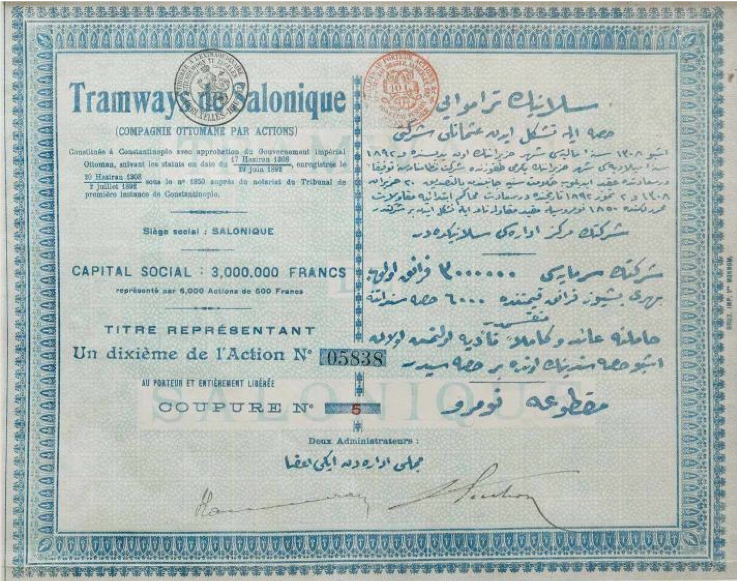
Image 1 - Tramways Salonique.
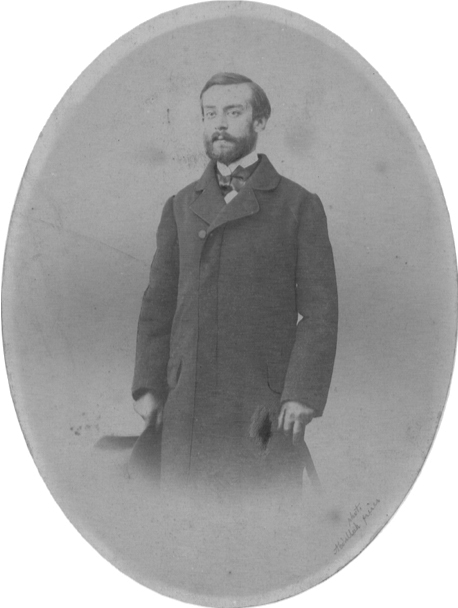
Image 2 - J Greindl.
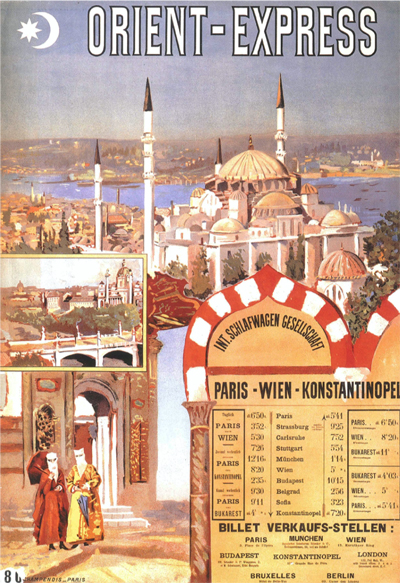
Image 3 - Orient Express.
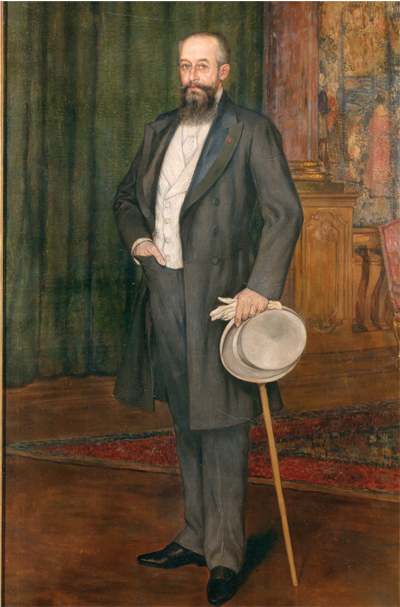
Image 4 - G Nagelmackers.
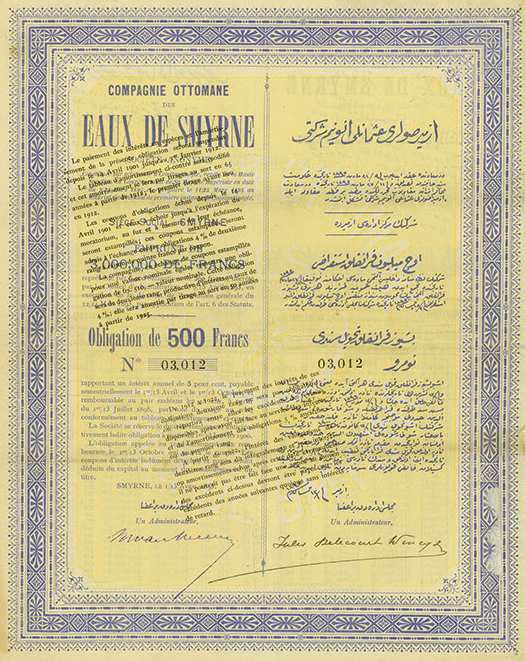
Image 5 - Eaux Smyrne.
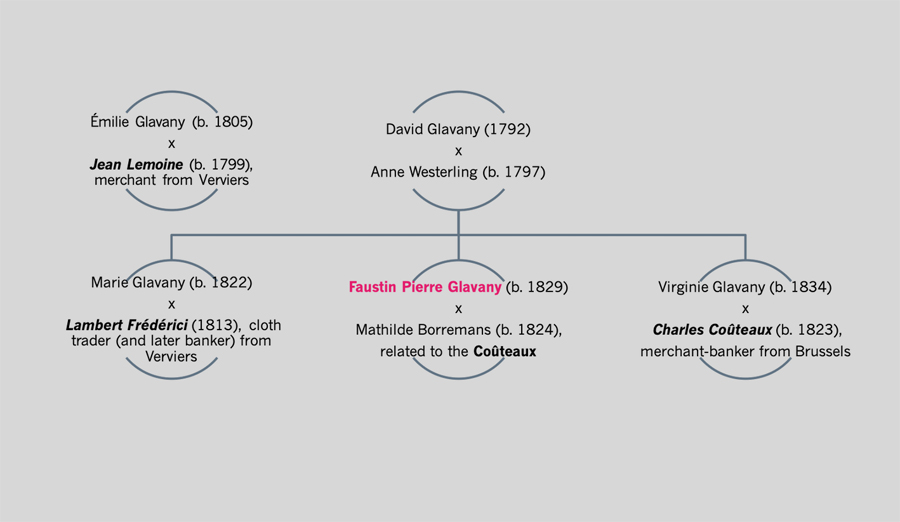
Image 6 - Glavany family.
Interview conducted by Craig Encer
